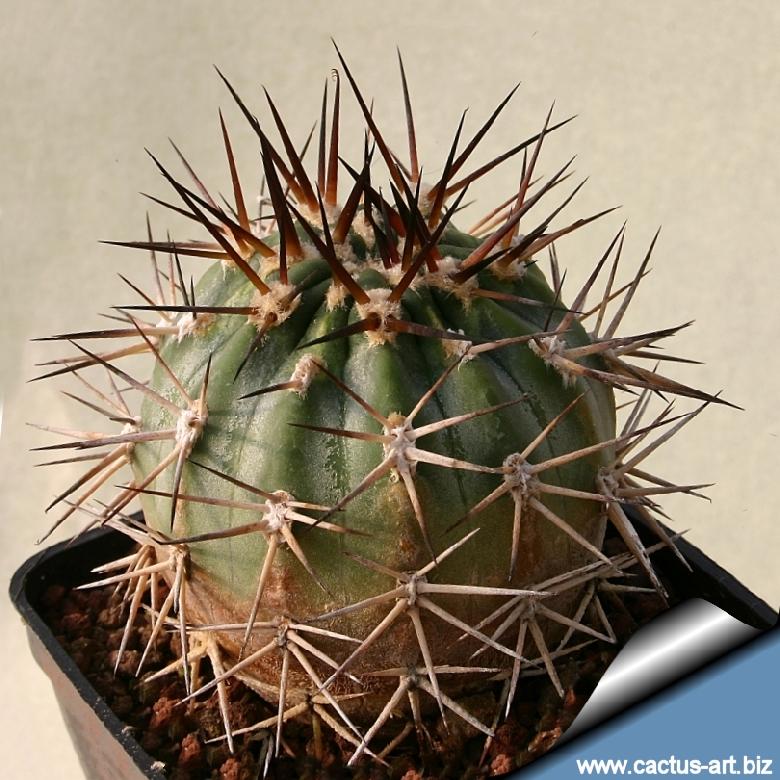Accepted Scientific Name: Echinopsis thionantha (Speg.) D.R.Hunt
Bradleya 5: 92 (1987)

Acanthocalycium griseum Photo by: Cactus Art
Origin and Habitat: Argentina (Salta)
Habitat: Mountain slopes
Synonyms:
See all synonyms of Echinopsis thionantha
back
Accepted name in llifle Database:Echinopsis thionantha (Speg.) D.R.HuntBradleya 5: 92 (1987)Synonymy: 19
back
Description: Usually solitary or slowly branching through basal shoots.
Stem: Spherical in time becomes slightly cylindrical, growing to a height of 12 cm or more, and a diameter of 6 to 10 cm. The epidermis is green to dark blue grey and become clear powdery-grey in the older part of the stem (like some Copiapoa)
Ribs: About 9-15.
Areoles: At the apex of tubercles, at first are covered with yellowish-brown felt. The lower part of the areola is elongated while the upper part curves around the sides of the rib, more or less in the shape of a small shield. As the tubercles widen in the course of growth, the areoles become elliptical and almost glabrous.
Spines: 5 to 10 radial spines and 1 to 4 central spines, they are all more or less of the same length in a given plant (± 0,5 -3 cm.), but this species appears to be very variable about the length colour and number of spines in different population. They usually are black or light brown at first, becoming grey or whitish-yellow as they ages.
Flowers: Bell-shaped 5 cm. long or less on lateral areoles and the segments of the perianth are sulfur- or lemon-yellow (but also white, orange or red), They have very hairy bud, The floral tubes have brown-white hairs /bristles and dark spine-tipped scales,
Cultivation and Propagation: Echinopsis grisea is an easy to grow succulent, more cold tolerant than most and less fussy regarding soil conditions.
Growth rate: It is a relatively rapidly growing and easily flowering species.
Soils: It likes very porous standard cactus mix soil.
Repotting: Use pot with good drainage.
Watering: Water regularly in summer, but do not overwater (Rot prone), keep dry in winter.
Fertilization: Feed with a high potassium fertilizer in summer.
Hardiness: Reputedly somewhat resistant to frost if kept on the dry side prior to, and during, cold weather (hardy to -12 C ° C, or less for short periods).
Exposition: Outside bright but filtered sunlight or afternoon shade, inside it needs bright light, and some direct sun. Tends to bronze in strong light, which encourages flowering and heavy spine production.
Uses: It is an excellent plant for container growing. It always looks good and stays small. It look fine in a cold greenhouse and frame or outdoor in a rockery.
Pests & diseases: It may be attractive to a variety of insects, but plants in good condition should be nearly pest-free, particularly if they are grown in a mineral potting-mix, with good exposure and ventilation. Nonetheless, there are several pests to watch for:
- Red spiders: Sensitive to red spider mite. Overhead watering is helpful in controlling mites.
- Mealy bugs: Occasionally mealy bugs they develop aerial into the new growth among the wool with disfiguring results, but the worst types develop underground on the roots and are invisible except by their effects.
- Scales: Scales are rarely a problem.
- Rot: Rot is only a minor problem with cacti if the plants are watered and “aired” correctly. If they are not, fungicides won't help all that much.
Propagation: Direct sow after last frost. Seeds germinate in 7-14 days at 21-27° C in spring, remove gradually the glass cover as soon the plants will be well rooted (ca 1-2 weeks) and keep ventilated, no full sun for young plants!











